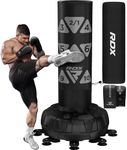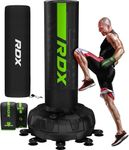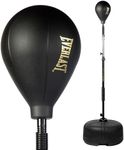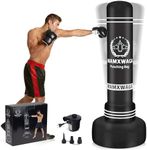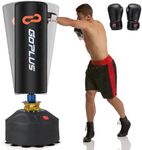Buying Guide for the Best Freestanding Heavy Bags
Choosing a freestanding heavy bag is all about matching the bag to your training style, available space, and physical needs. These bags are popular for boxing, kickboxing, and general fitness because they don’t require installation and can be moved around easily. To find the best fit, you’ll want to consider how you plan to use the bag, your strength and skill level, and the space where you’ll be training. Understanding the key features will help you make a confident choice.Bag WeightBag weight refers to how heavy the freestanding bag is when filled, and it’s crucial because it affects how much the bag moves when you hit or kick it. Lighter bags (under 100 lbs) are easier to move and are suitable for beginners or those focusing on speed and technique. Medium-weight bags (100-150 lbs) offer a balance between movement and stability, making them good for most users. Heavier bags (over 150 lbs) are best for powerful strikers who want minimal movement. Choose a weight that matches your strength and the intensity of your workouts—if you hit hard, go heavier to avoid too much wobble.
Height and AdjustabilityThe height of a freestanding heavy bag determines how well it suits different types of training, such as punches, kicks, or knee strikes. Some bags are fixed in height, while others are adjustable. Shorter bags (under 5 feet) are good for low kicks and basic boxing, while taller bags (over 5.5 feet) allow for a wider range of strikes, including high kicks. Adjustable bags are versatile and can grow with your training needs. Pick a height that matches your training style and your own height—taller users or those practicing kicks will benefit from a taller or adjustable bag.
Base Stability and Fill TypeThe base of a freestanding bag is what keeps it upright and stable. Bases can be filled with water or sand, with sand generally providing more weight and stability. A larger, heavier base will keep the bag from tipping or sliding during intense workouts. If you plan to hit or kick hard, look for a bag with a wide, heavy base. If you need to move the bag often, a lighter or water-filled base might be easier to manage. Consider your training intensity and whether you’ll need to move the bag when choosing the base type.
Bag Material and DurabilityThe outer material of the bag affects how it feels to hit and how long it will last. Common materials include synthetic leather, vinyl, and canvas. Synthetic leather is durable and feels similar to real leather, making it a popular choice for regular use. Vinyl is usually more affordable and easy to clean, but may wear out faster with heavy use. Canvas is tough but can be rough on the hands. If you plan to train frequently or with high intensity, choose a bag with a durable outer layer. For lighter or occasional use, a less expensive material may suffice.
Rebound and MovementRebound refers to how much the bag moves or bounces back when struck. Some bags are designed to swing or rebound more, which can help with timing and accuracy training, while others are more stationary for power strikes. If you want to practice footwork and dodging, a bag with more movement can be beneficial. If you prefer to focus on power and technique, a bag with minimal rebound is better. Think about your training goals and pick a bag that matches the style of workout you want.
